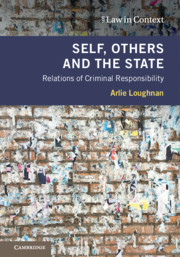Book contents
- Self, Others and the State
- The Law in Context Series
- Self, Others and the State
- Copyright page
- Dedication
- Contents
- Acknowledgements
- Table of Cases
- Table of Statutes
- Abbreviations
- Introduction
- Part I Rethinking Criminal Responsibility
- Part II Responsibility in Criminal Law
- 3 Modernisation through Form and Process
- 4 The ‘Birth’ of Australian Criminal Law
- 5 Peak Responsibility?
- Part III Criminal Responsibility in Relation
- Conclusion
- Bibliography
- Index
4 - The ‘Birth’ of Australian Criminal Law
The Role of Criminal Responsibility in the Mid-Century
from Part II - Responsibility in Criminal Law
Published online by Cambridge University Press: 11 November 2019
- Self, Others and the State
- The Law in Context Series
- Self, Others and the State
- Copyright page
- Dedication
- Contents
- Acknowledgements
- Table of Cases
- Table of Statutes
- Abbreviations
- Introduction
- Part I Rethinking Criminal Responsibility
- Part II Responsibility in Criminal Law
- 3 Modernisation through Form and Process
- 4 The ‘Birth’ of Australian Criminal Law
- 5 Peak Responsibility?
- Part III Criminal Responsibility in Relation
- Conclusion
- Bibliography
- Index
Summary
This chapter picks up the historical story in the middle of the twentieth century. Against a background of an enhanced sense of independence and confidence of people and institutions that developed following World War I and World War II, I argue that it was in the middle of the twentieth century, from the 1930s to 1960s, that Australian criminal law came into its own – measured in terms of an orientation around national coordinates, and in the self-confidence of its practitioners and academics. I demonstrate that, with close reference to the decisions of English courts, and commentaries such as that of Glanville Williams – and, increasingly over the period, to US developments like the Model Penal Code – Australian lawyers and commentators came to forge an independent path for the criminal law in the mid-century. Working over and above developments that occurred within state jurisdictions, and across code and common law modes of criminal law, practitioners and scholars were thoroughly engaged in a global debate about the development and improvement of the law of crime, and in a complex and subtle negotiation between what Australia shared with others, and what might be thought mark it out. In the mid-century, it became possible to think about Australian criminal law as such, to conceptualise Australian criminal law as a meaningful idea.
Keywords
- Type
- Chapter
- Information
- Self, Others and the StateRelations of Criminal Responsibility, pp. 104 - 133Publisher: Cambridge University PressPrint publication year: 2019

